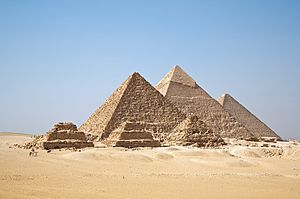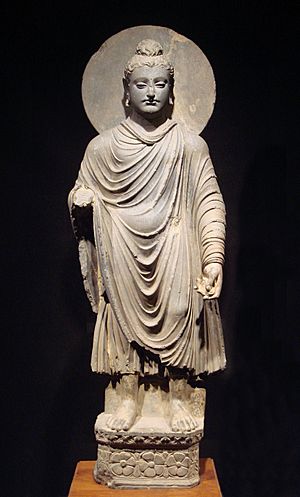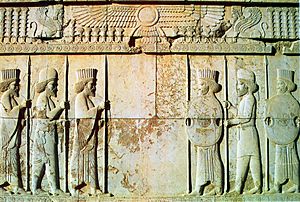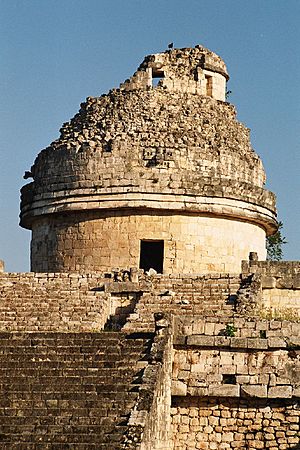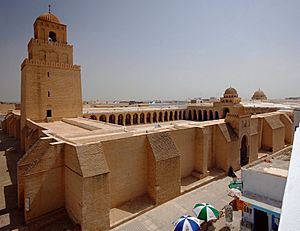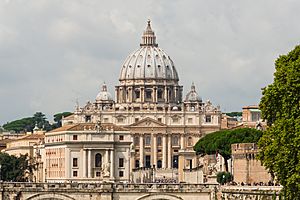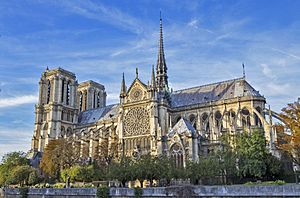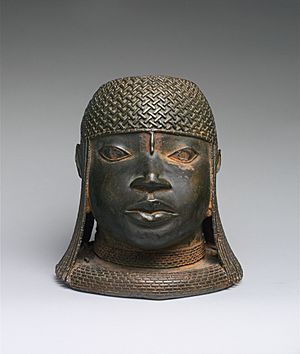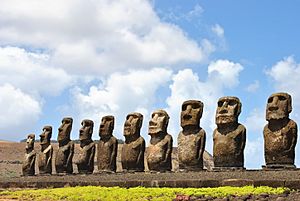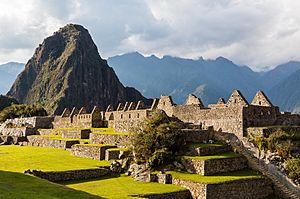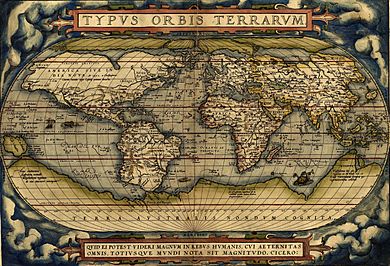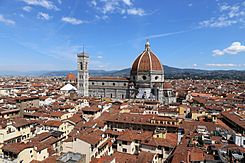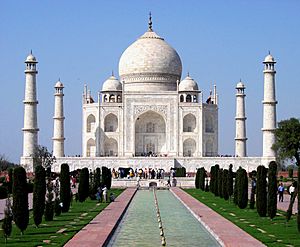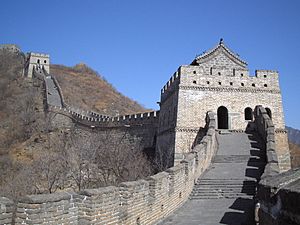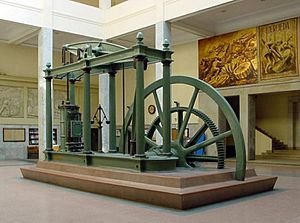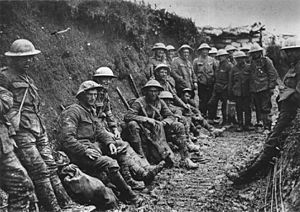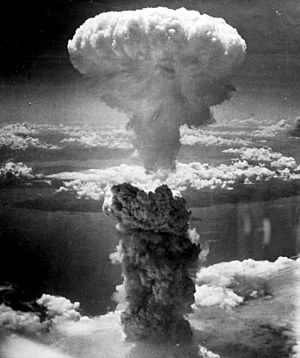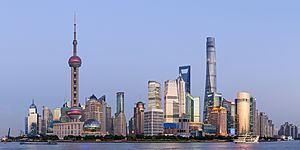Human history facts for kids

Human history is the story of how people have lived in the past. Humans first appeared in Africa about 300,000 years ago. Back then, they moved around a lot, hunting animals and gathering plants for food.
During the Last Glacial Period (also known as the Ice Age), humans started to move out of Africa. By the time the Ice Age ended 12,000 years ago, people had spread across most of the Earth. Soon after, the Agricultural Revolution began. This was a huge change! People learned to grow plants and raise animals for food. Many stopped moving around and settled down in permanent villages as farmers. As societies grew more complex, people needed ways to keep track of things, which led to the invention of accounting and writing.
Later, during the Bronze Age, Hinduism started in India. The Axial Age saw the rise of other major religions like Buddhism, Confucianism, Jainism, Judaism, Taoism, and Zoroastrianism. As civilizations grew, ancient history was filled with the rise and fall of powerful empires. The time after that, called post-classical history (or the "Middle Ages" from about 500 to 1500 CE), saw the spread of Christianity and Islam.
The early modern period (from about 1500 to 1800 CE) brought the Age of Discovery, when Europeans explored the world, and the Age of Enlightenment, a time of new ideas. By the 1700s, new knowledge and technology led to the Industrial Revolution. This marked the start of the late modern period, which began around 1800 CE and continues today.
While these historical periods (ancient, post-classical, early modern, and late modern) fit Europe's story well, other parts of the world like China and India had different timelines until the 1700s. By then, however, international trade and colonization had connected most civilizations around the globe. In the last 250 years, human population, farming, industry, trade, science, technology, communication, and even environmental degradation have all grown much faster.
Contents
- Prehistory: The First Humans (3.3 Million to 3000 BCE)
- Ancient History: Civilizations and Empires (3000 BCE to 500 CE)
- Post-Classical History: A Changing World (500 CE to 1500 CE)
- Early Modern Period: Global Connections (1500 CE to 1800 CE)
- Late Modern Period: The World Today (1800 CE – Present)
- See also
Prehistory: The First Humans (3.3 Million to 3000 BCE)
How Humans Evolved
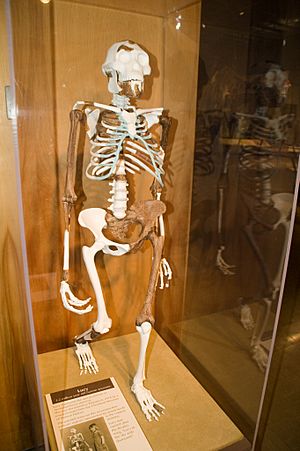
Humans developed in Africa from other primates. Scientists believe that the ancestors of modern humans separated from the ancestors of chimpanzees and bonobos (our closest living relatives) between 5 and 13 million years ago. These early human ancestors are called hominins. They include groups like Australopithecus and Homo.
Early hominins like Australopithecus had brains the same size as apes. But they were different because they started walking on two legs. This might have happened as their homes changed from forests to open grasslands. Hominins began using simple stone tools about 3.3 million years ago. This marked the beginning of the Paleolithic (Old Stone Age) era.
The Homo group evolved from Australopithecus. Early Homo species had bigger brains and smaller teeth. The oldest record of Homo is a 2.8-million-year-old fossil from Ethiopia. The first named species was Homo habilis, which appeared 2.3 million years ago. Homo erectus (sometimes called Homo ergaster in Africa) evolved 2 million years ago. This was the first hominin species to leave Africa and spread across Asia and Europe. Humans also started to use fire for warmth and cooking as early as 1.5 million years ago.
Around 500,000 years ago, the Homo group diversified into many new species of archaic humans. These included Neanderthals in Europe, Denisovans in Siberia, and the small Homo floresiensis in Indonesia. Human evolution wasn't a simple straight line. Different human species often interbred with each other. For example, modern non-African people have some DNA from Neanderthals.
Early Homo Sapiens and Their Journeys

Homo sapiens (modern humans) first appeared in Africa about 300,000 years ago. These early humans were skilled hunters. By 100,000 years ago, they were using jewelry and colors to decorate their bodies. By 50,000 years ago, they showed many modern behaviors, like burying their dead, using projectile weapons, and traveling by sea.
One of the most important changes was the development of language. This greatly improved how humans could communicate. Early art, like cave paintings and sculptures made from ivory, stone, and bone, suggests they had spiritual beliefs. Paleolithic humans were hunter-gatherers and usually nomadic, meaning they moved from place to place. They lived in grasslands or lightly wooded areas, avoiding dense forests.
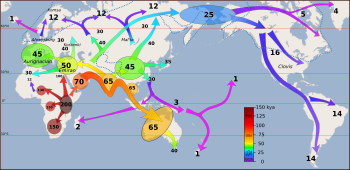
Modern humans started migrating out of Africa in several waves. The main idea among scientists is that all modern non-Africans are descended from one group that left Africa 70,000–50,000 years ago. Homo sapiens then spread to all continents and large islands. They reached Australia 65,000 years ago, Europe 45,000 years ago, and the Americas 21,000 years ago. These journeys happened during the last Ice Age, when many parts of the world were very cold. By the end of the Ice Age, about 12,000 years ago, humans had settled almost all ice-free parts of the world. This expansion happened at the same time as the extinction of many large animals and the Neanderthals. This was likely due to climate change, human activity, or both.
The Rise of Farming
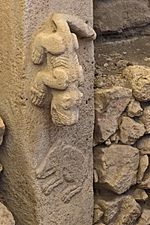
Around 10,000 BCE, the Neolithic Revolution began. This was when people started agriculture, which completely changed human life. Farming began in different parts of the world independently. People grew many different crops and domesticated various animals. For example, wheat, barley, sheep, and goats were farmed in Mesopotamia by 8500 BCE. Rice was grown in China's Yangtze River Valley around 8000 BCE, and millet in the Yellow River Valley by 7000 BCE. Pigs were also very important in early China.
In Africa, people in the Sahara grew sorghum and other crops between 8000 and 5000 BCE. Other farming centers appeared in the Ethiopian Highlands and West African rainforests. In the Indus River Valley, crops were grown by 7000 BCE, and cattle were domesticated by 6500 BCE. In the Americas, squash was grown in South America by 8500 BCE, and arrowroot in Central America by 7800 BCE. Potatoes and llamas were first used in the Andes mountains of South America. It's thought that women played a big role in domesticating plants.
Scientists aren't sure why the Neolithic Revolution happened. Some think it was because the population grew, forcing people to find new food sources. Others believe farming led to population growth because there was more food. Climate change and lack of resources might also have played a part. What we do know is that farming created extra food. This meant some people didn't have to farm, allowing for larger populations and the first cities and states.
Cities became centers for trade, making goods, and political power. They worked with the surrounding countryside, getting food and providing manufactured goods and some control. Early proto-cities like Jericho and Çatalhöyük appeared around 6000 BCE. Societies based on herding animals also developed, especially in dry areas not good for farming. Conflicts between nomadic herders and settled farmers were common throughout history.
People started using metalworking around 6400 BCE, first with copper for tools and decorations. Gold and silver followed, mainly for ornaments. The need for metal ores encouraged trade. The first signs of bronze, a mix of copper and tin, appeared around 2500 BCE, but it became widely used later.
Neolithic societies often worshipped ancestors, special places, or gods that looked like humans. The Sun, Moon, Earth, sky, and sea were often seen as gods. Göbekli Tepe in Turkey, built between 9500–8000 BCE, is an amazing example of a Neolithic religious site. It might have been built by hunter-gatherers. People in the Levant also developed special ways to bury the dead. They sometimes buried high-status people under house floors, then later dug up the skulls, covered them in plaster, painted them, and displayed them.
Ancient History: Civilizations and Empires (3000 BCE to 500 CE)
The First Civilizations
The Bronze Age saw the growth of cities and civilizations. The first civilizations appeared near rivers:
- Mesopotamia (3000 BCE) along the Tigris and Euphrates rivers.
- Ancient Egypt (3000 BCE) along the Nile River.
- Indus Valley civilization (2500 BCE) in Pakistan and northwest India.
- Ancient China (2200 BCE) along the Yangtze and Yellow Rivers.
These societies shared many features: a central government, a complex economy, social classes, ways to keep records, and unique cultures and religions. They invented the wheel, mathematics, bronze-working, sailing boats, the potter's wheel, woven cloth, huge buildings, and writing. They often had many gods, worshipped in temples where priests and priestesses performed rituals.
Writing helped manage cities, share ideas, and save information. Writing developed independently in at least four places: Mesopotamia (3300 BCE), Egypt (around 3250 BCE), China (1200 BCE), and Mesoamerica (by 650 BCE). Some of the oldest religious writings are the Egyptian Pyramid Texts from 2400–2300 BCE.
Sumer, in Mesopotamia, was the first known complex civilization. It developed the first city-states in the 4th millennium BCE. These cities created the earliest known writing, cuneiform script. Cuneiform started as picture-symbols that became simpler over time. Scribes wrote on clay tablets using a reed stylus.
Travel was easier by water, on rivers and seas. The Mediterranean Sea, connecting three continents, helped spread military power, goods, ideas, and inventions. New land technologies, like horse-based cavalry and chariots, made armies faster. Trade became very important, as states with valuable resources or control over trade routes grew powerful.
As cities grew, states and empires formed. In Mesopotamia, city-states often fought each other. In Egypt, the country was united around 3100 BCE. The Minoan civilization on Crete entered the Bronze Age by 2700 BCE and is considered Europe's first civilization. Around 2600 BCE, the Indus Valley civilization built large cities like Harappa and Mohenjo-daro. They had a writing system with over 400 symbols, which we still can't read today. China entered the Bronze Age by 2000 BCE. The Shang dynasty (1766–1045 BCE) was the first to use writing, carving predictions on animal bones and turtle shells. Later, the Akkadian Empire and Neo-Sumerians rose in Mesopotamia.
Over the next thousands of years, civilizations developed worldwide. By 1600 BCE, Mycenaean Greece began to grow. It thrived until the Late Bronze Age collapse (1300–1000 BCE) affected many Mediterranean civilizations. In India, the Vedic period (1750–600 BCE) laid the foundations for Hinduism and other parts of early Indian society. This period ended in the 6th century BCE. The Vedas (ancient texts) mention India's caste system, which divided society into four main groups: priests, warriors, farmers/traders, and laborers. From around 550 BCE, many independent kingdoms and republics, called Mahajanapadas, were established across India.
Speakers of Bantu languages began to spread across Central and Southern Africa as early as 3000 BCE. Their movement led to the spread of farming and ironworking throughout sub-Saharan Africa. This created societies like the Nok culture in modern Nigeria by 500 BCE. The Lapita culture appeared near New Guinea around 1500 BCE. They settled many islands in Remote Oceania, reaching as far as Samoa by 700 BCE.

In the Americas, the Norte Chico culture appeared in coastal Peru around 3100 BCE. They built large public buildings at the city of Caral. The later Chavín is sometimes called the first Andean state. Other important Andean cultures include the Moche, known for their pottery showing daily life, and the Nazca, who created huge animal designs in the desert called Nazca lines. The Olmecs of Mesoamerica developed around 1200 BCE. They are famous for their huge stone heads carved from basalt. They also created the Mesoamerican calendar, which was used by later cultures like the Maya and Teotihuacan. Societies in North America were mainly hunter-gatherers. They built large earth mounds, like Watson Brake (4000 BCE) and Poverty Point (3600 BCE) in Louisiana.
The Axial Age: New Ways of Thinking
From 800–200 BCE, a special time called the "Axial Age" saw the development of powerful new ideas in philosophy and religion. These ideas often developed independently in different places. Chinese Confucianism, Indian Buddhism and Jainism, and Jewish monotheism (belief in one God) all grew during this time. Persian Zoroastrianism started earlier but became more organized during the Axial Age. New philosophies also took hold in Greece in the 5th century BCE, with thinkers like Plato and Aristotle.
Axial Age ideas were incredibly important for later history. Confucianism became one of the main ways of thinking in China, along with Taoism and Legalism. Confucianism focused on morality and tradition rather than strict laws. It later spread to Korea and Japan. Buddhism reached China during the Han dynasty and spread widely, becoming a major religion in much of South, Southeast, and East Asia. Greek philosophy spread throughout the Mediterranean and even to India after the conquests of Alexander the Great. The Christian and Muslim religions are both based on the Jewish idea of one God.
Great Empires Rise and Fall
The thousand years from 500 BCE to 500 CE saw the rise of huge empires. These empires had well-trained armies, shared beliefs, and organized governments. Emperors could rule over vast lands with millions of people. These great empires grew by conquering new lands and building defended settlements that became farming centers. International trade also grew, with major routes across the Mediterranean Sea, the Indian Ocean, and the Silk Road.
Many regional empires existed during this time. The kingdom of the Medes helped destroy the Assyrian Empire in 612 BCE. The Median Empire was followed by other Iranian empires, including the Achaemenid Empire (550–330 BCE), the Parthian Empire (247 BCE–224 CE), and the Sasanian Empire (224–651 CE).
Several empires started in modern-day Greece. The Delian League and the Athenian Empire were examples. Later, Alexander the Great (356–323 BCE) of Macedon built an empire from Greece to India. His empire split after his death, but it spread Greek culture everywhere it had conquered, a process called Hellenization. This Hellenistic period lasted from 323 to 31 BCE.
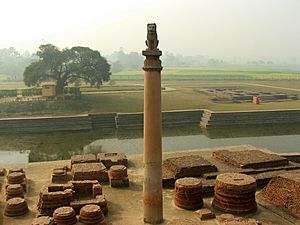
In Asia, the Maurya Empire (320–185 BCE) existed in India. In the 3rd century BCE, most of South Asia was united under the Maurya Empire by Chandragupta Maurya and thrived under Ashoka the Great. From the 4th to 6th centuries, the Gupta dynasty ruled during what is called ancient India's Golden Age. This stability led to a flourishing of Hindu and Buddhist culture, and major advances in science and mathematics. In South India, three important Dravidian kingdoms emerged: the Cheras, Cholas, and Pandyas.
Speakers of the Bantu languages began expanding across Central and Southern Africa as early as 3000 BCE. Their expansion and encounters with other groups resulted in the spread of mixed farming and ironworking throughout sub-Saharan Africa, and produced societies such as the Nok culture in modern Nigeria by 500 BCE. The Lapita culture emerged in the Bismarck Archipelago near New Guinea around 1500 BCE and colonized many uninhabited islands of Remote Oceania, reaching as far as Samoa by 700 BCE.

In Europe, the Roman Empire, centered in present-day Italy, began in the 7th century BCE. By the 3rd century BCE, the Roman Republic started expanding through conquest. By the time of Augustus, the first Roman Emperor, Rome controlled most of the Mediterranean Sea. The empire continued to grow, reaching from England to Mesopotamia under Trajan. In the 4th century CE, the empire split into western and eastern parts. The Western Roman Empire fell in 476 CE to Germanic tribes. The Eastern Roman Empire, known as the Byzantine Empire, with its capital at Constantinople, lasted another thousand years until it was conquered by the Ottoman Empire in 1453. The Byzantine Empire was a powerful economic, cultural, and military force in Europe.
In China, the Qin dynasty (221–206 BCE) was the first imperial dynasty. It was followed by the Han dynasty (202 BCE–220 CE). The Han dynasty was as powerful as the Roman Empire, which was at the other end of the Silk Road. Han China developed advanced map-making, shipbuilding, and navigation. The Chinese invented cast iron and created beautiful bronze figures. Like other empires of this period, Han China made great strides in government, education, mathematics, astronomy, and technology.
In Africa, the Kingdom of Aksum, in present-day Ethiopia, became a major trading empire by the 1st century CE. It controlled trade in the Red Sea and minted its own money.
Successful empires also rose in the Americas. In Mesoamerica, large pre-Columbian societies were built, like the Zapotec civilization (700 BCE–1521 CE) and the Maya civilization. The Maya reached their peak between 250–900 CE. Their great city-states grew in number and influence, and Maya culture spread throughout the Yucatán Peninsula. The Maya developed a writing system and were the first to use the concept of zero in their math. West of the Maya, in central Mexico, the city of Teotihuacan grew powerful by controlling the obsidian trade. It peaked around 450 CE, with 125,000–150,000 people, making it one of the world's largest cities.
Technology developed at different rates in the ancient world. There were times of rapid progress, like the Hellenistic period in the Mediterranean, when many inventions were made. There were also times of decline, like during the fall of the Roman Empire. Two very important inventions were the stirrup (Central Asia, 1st century CE) and paper (China, 1st and 2nd centuries CE), both of which spread widely. The Chinese also learned to make silk and built huge projects like the Great Wall of China and the Grand Canal. The Romans were also great builders, inventing concrete and perfecting the use of arches in construction.
Most ancient societies had slaves. Slavery was very common in Athens and Rome, where slaves made up a large part of the population and were essential to the economy.
Decline and Comeback
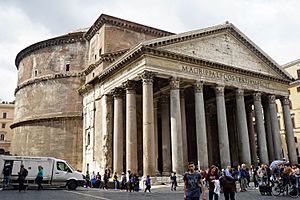
The ancient empires faced challenges in supporting huge armies and central governments. These costs often fell heavily on farmers. Meanwhile, rich landowners became more independent. Attacks from "barbarian" groups on the borders also weakened the empires. China's Han dynasty fell into civil war in 220 CE, starting the Three Kingdoms period. The Roman Empire also became less centralized around the same time, in what is called the Crisis of the Third Century. From the Eurasian Steppe, horse-riding nomads became a constant threat to settled civilizations.
The Roman Empire slowly broke apart as Christianity spread from West Asia. The Western Roman Empire fell to Germanic tribes in the 5th century. These new kingdoms gradually developed into warring states, often connected to the Catholic Church. The eastern part of the Roman Empire continued as the Byzantine Empire. Centuries later, a limited unity returned to Western Europe with the creation of the Holy Roman Empire in 962.
In China, dynasties rose and fell, but unlike in Europe, unity was always restored. After the fall of the Eastern Han dynasty, nomadic tribes from the north invaded, causing many Chinese people to move south. The Sui dynasty reunified China in 581. This laid the groundwork for a Chinese golden age under the Tang dynasty (618–907). China faced several collapses, but each time, the empire was rebuilt.
Post-Classical History: A Changing World (500 CE to 1500 CE)
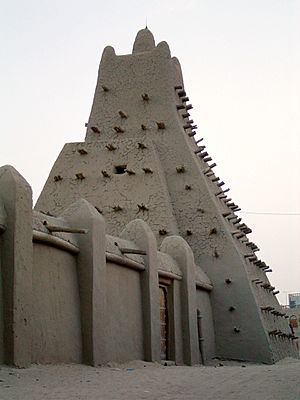
The "post-classical era" (also called the Middle Ages) covers a wider area than just Europe. It usually starts with the fall of the Western Roman Empire in the 5th century, which broke into many separate kingdoms. The Byzantine Empire survived until the end of this period.
From the 10th to 13th centuries, a warm period in the Northern Hemisphere helped farming and led to population growth in parts of Europe and Asia. This was followed by the Little Ice Age and plagues in the 14th century, which reduced populations. Some major inventions of this period were gunpowder, printing, and the compass, all of which came from China.
This period saw the early Muslim conquests, followed by the Islamic Golden Age. It also included the start of the Arab slave trade, the Mongol invasions, and the founding of the Ottoman Empire. South Asia saw many middle kingdoms of India, then the establishment of Islamic empires.
In West Africa, the Mali and Songhai Empires grew powerful. On Africa's southeast coast, Arabic ports were set up for trading gold, spices, and other goods. This connected Africa to the Southeast Asian trading system and led to the Swahili culture, influenced by Muslim traditions.
China experienced the Sui, Tang, Song, Yuan, and early Ming dynasties. Trade routes like the Indian Ocean routes and the Silk Road provided some economic and cultural contact between Asian and European civilizations.
During the same time, civilizations in the Americas, such as the Mississippians, Aztecs, Maya, and Inca, reached their peak.
The Greater Middle East
Before Islam in the 7th century, the Middle East was dominated by the Byzantine and Sasanian Empires, who often fought. The birth of Islam created a new power that quickly surpassed both empires. This new religion greatly changed the history of the Old World, especially the Middle East.
From the Arabian Peninsula, Muslims began to expand in the 7th century. By 750 CE, they had conquered most of the Middle East, North Africa, and parts of Europe. This began an era of great learning, science, and invention known as the Islamic Golden Age. Muslims preserved knowledge from the ancient Middle East, Greece, and Persia. They also added new ideas, like paper manufacturing from China and decimal numbers from India. Islamic civilization grew through both conquest and trade. Merchants brought goods and their Islamic faith to China, India, Southeast Asia, and Africa.
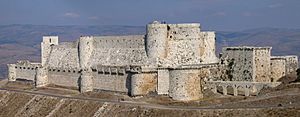
The crusading movement was a series of religious wars by Europeans to take control of the Holy Land from Muslims. It didn't succeed in the long run and mostly weakened the Byzantine Empire, especially after the sack of Constantinople in 1204. Arab control of the region ended in the mid-11th century with the arrival of the Seljuk Turks. In the early 13th century, the Mongols swept through the region but were later replaced by the Turks and the founding of the Ottoman Empire around 1280.
North Africa saw the rise of states founded by the Berbers, like Marinid Morocco and Hafsid Tunisia. The coastal region was known as the Barbary Coast. Pirates from North African ports captured merchant ships and raided coastal settlements. Many European captives were sold as slaves.
In the Caucasus region, different groups of people gained freedom from foreign rule as the Byzantines and Sasanians weakened from constant wars. The Rashidun Caliphate expanded into the Caucasus during the early Muslim conquests. In the 13th century, the Mongols invaded the region multiple times.
Starting with the Sui dynasty (581–618), the Chinese began expanding west. They met Turkic nomads, who were becoming dominant in Central Asia. In the 8th century, Islam began to spread in the region and soon became the main faith for most people. From the 9th to 13th centuries, the region was divided among powerful states like the Samanid and Seljuk empires. In 1370, Timur, a Turkic leader, conquered most of the region and founded the Timurid Empire. However, his empire collapsed after his death.
Europe in the Middle Ages
Since at least the 4th century, Christianity (especially Catholicism) has played a huge role in shaping Western civilization. Europe during the Early Middle Ages experienced population decline, cities shrinking, and invasions by various groups. These invaders formed new kingdoms in the remains of the Western Roman Empire. Christianity spread in Western Europe, and monasteries were founded. In the 7th and 8th centuries, the Franks under the Carolingian dynasty created an empire covering much of Western Europe. It lasted until the 9th century when new invaders like the Vikings, Magyars, and Arabs attacked.
During the High Middle Ages (after 1000 CE), Europe's population grew as new technologies and farming methods improved trade and crop yields. Manorialism (peasants working for nobles) and feudalism (knights and nobles serving overlords for land) were ways medieval society was organized. Kingdoms became more centralized. In 1054, the Great Schism divided the Catholic and Eastern Orthodox Churches, leading to cultural differences between Western and Eastern Europe. The Crusades were religious wars by Christians to take control of the Holy Land from Muslims. Italian merchants imported slaves for households or sugar production. Intellectual life saw the rise of scholasticism and universities. Building Gothic cathedrals and churches was a major artistic achievement.
The Mongols reached Europe in 1236, conquering Russia and briefly invading Poland and Hungary.
The Late Middle Ages were difficult. Famine, plague, and war devastated Western Europe. The Black Death alone killed about 75 to 200 million people between 1347 and 1350. It was one of the deadliest pandemics in human history. Starting in Asia, the disease reached Europe in the late 1340s, killing tens of millions of Europeans in six years, about a quarter to a third of the population.
The Middle Ages saw the first sustained growth of cities in Northern and Western Europe. This period lasted until the beginning of the early modern period in the 16th century, which brought the rise of nation states, the division of Western Christianity in the Reformation, the birth of humanism in the Renaissance, and the start of European exploration overseas.
Sub-Saharan Africa
Medieval sub-Saharan Africa was home to many different civilizations. In the Horn of Africa, the Kingdom of Aksum declined in the 7th century. The later Zagwe dynasty was famous for its rock-cut churches at Lalibela. The Zagwe were followed by the Solomonic dynasty, who ruled Ethiopia until the 20th century.
In the West African Sahel region, many Islamic empires rose, such as the Ghana, Mali, Songhai, and Kanem–Bornu Empires. They controlled the trans-Saharan trade in gold, salt, and slaves. West Africa became the world's largest gold exporter by the 14th century.
South of the Sahel, civilizations grew in the coastal forests. These include the Yoruba city of Ifẹ, known for its art, and the Oyo Empire. Also, the Edo Kingdom of Benin (centered in Benin City), the Igbo Kingdom of Nri (which produced advanced bronze art), and the Akan (known for their architecture).
Central Africa saw the formation of states like the Kingdom of Kongo. In modern Southern Africa, native Africans created kingdoms like the Kingdom of Mutapa. They thrived by trading with the Swahili on the East African coast. They built large stone structures without mortar, like Great Zimbabwe. The Swahili people themselves lived on the East African coast and traded extensively with Arabs, who introduced them to Islam. They built many port cities like Mombasa and Kilwa.
Seafarers from Southeast Asia settled Madagascar between the 4th and 9th centuries. They traveled 6,000 miles of ocean in canoes, likely without maps or compasses. A wave of Bantu-speaking migrants from southeastern Africa also arrived in Madagascar around 1000 CE.
South Asia
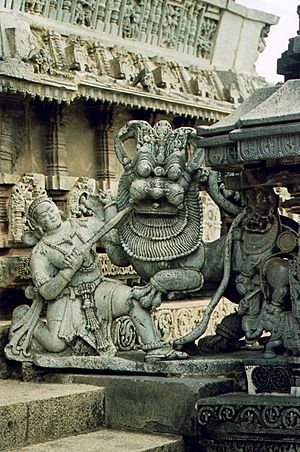
After the fall of the Gupta Empire (550 CE), North India was divided into many smaller kingdoms. Early Muslim incursions began in the northwest in 711 CE, when the Arab Umayyad Caliphate conquered much of modern-day Pakistan. The Arab military advance largely stopped there, but Islam still spread in India, mainly through Arab merchants along the western coast. The 9th century saw a struggle for control of North India among the Pratihara, Pala, and Rashtrakuta Empires.
Post-classical dynasties in South India included the Chalukyas, Hoysalas, Cholas, and Mysores. Science, engineering, art, literature, astronomy, and philosophy flourished under these kings. Other important states in South India during this time included the Bahmani Sultanate and Vijayanagara Empire.
Northeast Asia

After a period of disunity, China was reunified by the Sui dynasty in 589. Under the succeeding Tang dynasty (618–907), China entered a Golden Age. The Sui and Tang dynasties started the long-lasting imperial examination system, where government jobs were given only to those who passed difficult tests on Confucian ideas. China competed with Tibet for control of areas in Inner and Central Asia. The Tang dynasty eventually broke apart. After half a century of chaos, the Song dynasty reunified much of China. At this time, China was "the richest, most skilled, and most populous country on earth." Pressure from nomadic empires to the north grew. By 1127, North China was lost to the Jurchens. The Mongols conquered all of China in 1279. After about a century of Mongol rule (Yuan dynasty), the Chinese regained control with the founding of the Ming dynasty in 1368.
In Japan, the imperial family was established. During the Asuka period (538–710), the Yamato Province became a centralized state. Buddhism was introduced, and there was an emphasis on adopting parts of Chinese culture and Confucianism. The Nara period (710–794) saw the start of Japanese literature and the development of Buddhist art and architecture. The Heian period (794–1185) was the peak of imperial power, followed by the rise of military clans and the beginning of Japanese feudalism. The feudal period, dominated by powerful regional lords (daimyos) and military rulers (shoguns), lasted from 1185 to 1868. The emperor remained, but mostly as a symbol.
Postclassical Korea saw the end of the Three Kingdoms era (Goguryeo, Baekje, and Silla). Silla conquered Baekje in 660 and Goguryeo in 668, starting the Northern and Southern States period. In 892 CE, this arrangement reverted to the Later Three Kingdoms, with Goguryeo (later called Goryeo) becoming dominant and uniting the entire peninsula by 936. The Goryeo dynasty ruled until 1392, followed by the Joseon dynasty, which ruled for about 500 years.
In Mongolia, Genghis Khan united the various tribes. The Mongol Empire expanded to include all of China and Central Asia, as well as large parts of Russia and the Middle East. After Möngke Khan died in 1259, the Mongol Empire was divided into four separate states.
Southeast Asia
The Southeast Asian kingdom of Funan declined in the 6th century as Chinese trade routes shifted. It was replaced by the Khmer Empire in 802 CE. The Khmers' capital city, Angkor, was the largest city in the world before the industrial age. It contained Angkor Wat, the world's largest religious monument. The Sukhothai (mid-13th century CE) and Ayutthaya Kingdoms (1351 CE) were major powers of the Thais, who were influenced by the Khmers.
Starting in the 9th century, the Pagan Kingdom rose in modern Myanmar. Its collapse led to political division, which ended with the rise of the Toungoo Empire in the 16th century. Other notable kingdoms of this period include Srivijaya and Lavo (both prominent in the 7th century), Champa and Hariphunchai (both around 750), Đại Việt (968), Lan Na (13th century), Majapahit (1293), Lan Xang (1353), and Ava (1365).
This period saw Islam spread to present-day Indonesia (starting in the 13th century) and the emergence of the Malay states, including Brunei and Malacca. In the Philippines, several states formed, such as Tondo and Butuan.
Oceania
The Polynesians, descendants of the Lapita peoples, settled vast areas of Remote Oceania starting around 1000 CE. They traveled the open ocean in large double-hulled canoes, carrying up to 50 people and their animals. Their voyages led to the settlement of hundreds of islands, including the Marquesas, Hawaii, Rapa Nui (Easter Island), and New Zealand.
The Tuʻi Tonga Empire was founded in the 10th century CE and expanded between 1250 and 1500. Tongan culture and influence spread throughout eastern Melanesia, Micronesia, and central Polynesia. In Northern Australia, there is evidence that Aboriginal Australians regularly traded with Makassan trepangers from Indonesia before Europeans arrived.
The question of whether Polynesians and Indigenous Americans had contact before Columbus has been debated. In 2020, DNA analysis showed evidence of mixing between Polynesians and pre-Columbian Zenú people in South America around 1200 CE. It's not clear if Indigenous Americans reached Polynesia or if Polynesians visited South America.
On Rapa Nui, the islanders carved hundreds of moai, huge stone statues that could weigh up to 80 tons. The moai are thought to represent important ancestors. All were pulled down during a chaotic period after European contact. Rapa Nui is also the only Polynesian island to have a writing system, the rongorongo script, though it remains undeciphered.
The Americas
In North America, this period saw the rise of the Mississippian culture in the modern-day United States around 950 CE. This included the large urban center at Cahokia in the 11th century. The Ancestral Puebloans (9th – 13th centuries) built extensive permanent settlements, including stone structures that were the largest buildings in North America until the 1800s.
In Mesoamerica, the Teotihuacan civilization fell, and the classic Maya collapse occurred. The Aztec Empire came to control much of Mesoamerica in the 14th and 15th centuries.
In South America, the 15th century saw the rise of the Inca. The Inca Empire, or Tawantinsuyu, with its capital at Cusco, covered the entire Andes mountains. It was the largest pre-Columbian civilization. The Inca were prosperous and advanced, known for an excellent road system and beautiful stonework.
Early Modern Period: Global Connections (1500 CE to 1800 CE)
The "early modern period" was the time between the Middle Ages and the Industrial Revolution, roughly from 1500 to 1800. This period was marked by the rise of science, faster technological progress, more secular (non-religious) politics, and the growth of nation states.
Capitalist economies began to rise, first in northern Italy. This period saw the dominance of mercantilist economic ideas. Feudalism, serfdom, and the power of the Catholic Church declined in much of Europe.
The period included the Reformation (a split in Christianity), the Thirty Years' War, the Age of Discovery, European colonial expansion, the Scientific Revolution, and the Age of Enlightenment. During this time, Protestantism became the main religion in Northwestern Europe, England, and English-speaking America.
European Expansion Around the World
During this period, European powers came to control much of the world. Even though Europe had gone through a long period of decline, it regained its dominance. Historians still debate why this happened.
The 15th, 16th, and 17th centuries saw the rise of European maritime empires. First came the Portuguese and Spanish Empires, then the French, English, and Dutch Empires. In the 17th century, private companies like the English East India Company (founded 1600) and the Dutch East India Company (founded 1602) were created.
The Age of Discovery was the first time that Europe, Asia, and Africa had major cultural, material, and biological exchanges with the New World (the Americas). It began in the late 15th century when Portugal and Castile (part of Spain) sent the first voyages around the Cape of Good Hope and to the Americas. Christopher Columbus "discovered" the Americas in 1492. Around 1500, the Portuguese started setting up trading posts from Africa to Asia and Brazil, trading in goods like slaves, gold, spices, and lumber.
Global connections continued as European colonization of the Americas started the Columbian exchange. This was the exchange of plants, animals, foods, people (including slaves), diseases, and culture between the Eastern and Western Hemispheres. It was one of history's most important global events. New crops brought from the Americas by European sailors in the 16th century greatly helped world population growth.
Regional Changes Around the World
Greater Middle East
After conquering Constantinople in 1453, the Ottoman Empire quickly became dominant in the Middle East. Persia came under the rule of the Safavids in 1501, followed by other dynasties. In North Africa, the Berbers remained in control of independent states until the 16th century. By the end of the 18th century, the Russian Empire began its conquest of the Caucasus. Areas to the north and east in Central Asia were held by the Uzbeks and Pashtuns.
Europe
Europe's Renaissance – a "rebirth" of classical culture – began in Italy in the 14th century and lasted into the 16th. It involved rediscovering the cultural, scientific, and technological achievements of the classical world. The Renaissance encouraged curiosity, which led to humanism and the Scientific Revolution. This period is also famous for its art and literature, like Petrarch's poetry and the paintings of Leonardo da Vinci and Michelangelo.
In Russia, Ivan the Terrible became the first tsar in 1547. By conquering Turkic lands to the east, he made Russia a regional power. Western European countries expanded greatly through technology and colonies. They also competed with each other economically and militarily, often in almost constant war. Wars often had a religious side, like Catholics versus Protestants, or Christians versus Muslims. Important wars included the Thirty Years' War and the Seven Years' War. Napoleon Bonaparte came to power in France in 1799, leading to the Napoleonic Wars in the early 1800s.
Sub-Saharan Africa
In Africa, this period saw some civilizations decline and others advance. Between 1515 and 1800, Africa lost millions of people to the Atlantic slave trade (to the Americas) and the Arab slave trade (across the Sahara and Indian Ocean). The Swahili Coast was influenced by trade with the Portuguese and later the Omanis. In West Africa, the Songhai Empire fell after an invasion by the Moroccans. The Bono state gave rise to many Akan states like Ashanti. The Kingdom of Zimbabwe was replaced by smaller kingdoms.
The Ethiopian Empire suffered from an invasion in 1531. In 1769, it entered the Zemene Mesafint (Age of Princes), where the Emperor became a figurehead and warlords ruled. Other African civilizations advanced. The Oyo Empire and the Kingdom of Benin experienced golden ages. The Ashanti Empire rose to power in modern-day Ghana in 1670. The Kingdom of Kongo also thrived.
South Asia
In the Indian subcontinent, the Mughal Empire began under Babur in 1526 and lasted for two centuries. Starting in the northwest, the Mughal Empire eventually ruled almost the entire subcontinent by the late 17th century.
Against the Muslim Mughal Empire, the Hindu Maratha Empire was founded by Shivaji on the western coast in 1674. The Marathas gradually gained territory from the Mughals. The Maratha Empire eventually fell under the control of the British East India Company in 1818.
During the same period, Sikhism developed from the teachings of ten gurus. In 1799, Ranjit Singh established the Sikh Empire in the Punjab. The British East India Company took over the Sikh Empire after a war in 1849.
Northeast Asia
In 1644, the Ming dynasty was replaced by the Qing, the last Chinese imperial dynasty, which ruled until 1912. Japan experienced its Azuchi–Momoyama period (1568–1600), followed by the Edo period (1600–1868). The Korean Joseon dynasty (1392–1910) ruled throughout this period, fighting off invasions from Japan and China. Increased sea trade with Europe greatly affected China and Japan, especially through the Portuguese. However, China and Japan later adopted isolationist policies to limit foreign influences.
Southeast Asia
In 1511, the Portuguese took over the Malacca Sultanate in present-day Malaysia and Indonesia. The Portuguese held this important trading area until the Dutch took it in 1641. The Johor Sultanate became the main trading power in the region.
European colonization expanded, with the Dutch in Indonesia, the Portuguese in Timor, and the Spanish in the Philippines. Into the 19th century, European expansion affected all of Southeast Asia. Only Thailand successfully resisted colonization.
Oceania
The Pacific islands of Oceania were also affected by European contact. This began with the voyage of Ferdinand Magellan (1519–1522), who landed in the Marianas. Abel Tasman (1642–1644) sailed to present-day Australia, New Zealand, and nearby islands. James Cook (1768–1779) made the first recorded European contact with Hawaii. In 1788, Britain founded its first colony in Australia.
The Americas
In the Americas, several European powers actively colonized the newly discovered continents. They largely displaced the native populations and destroyed the advanced civilizations of the Aztecs and Inca. Diseases brought by Europeans devastated American societies, killing 60–90 million people by 1600. Spain, Portugal, Britain, and France all claimed large territories and brought many African slaves. Portugal claimed Brazil. Spain claimed the rest of South America, Mesoamerica, and southern North America. The Spanish mined and exported huge amounts of silver from the Americas. This silver boom, along with increased Japanese silver mining, caused a surge in inflation in the 16th and 17th centuries.
Britain colonized the east coast of North America, and France colonized the central region. Russia made inroads on the northwest coast of North America, with a first colony in present-day Alaska in 1784. In 1762, France secretly gave most of its North American claims to Spain. Thirteen of the British colonies declared independence as the United States of America in 1776. Napoleon won France's claims back from Spain in 1800 but sold them to the United States in the Louisiana Purchase of 1803.
Late Modern Period: The World Today (1800 CE – Present)
The 19th Century
The Scientific Revolution changed how humans understood the world. It was followed by the Industrial Revolution, a major change in the world's economies. The Scientific Revolution in the 17th century didn't immediately affect industrial technology. Only in the second half of the 19th century did scientific advances truly begin to be used in practical inventions. The Industrial Revolution started in Great Britain. It used new ways of making things, like factories, mass production, and mechanization, to produce goods faster and with less labor.
European empires lost territory in Latin America, which gained independence by the 1820s. But they expanded elsewhere. Britain gained control of India, Burma, and the Malay Peninsula. The French took Indochina, while the Dutch strengthened their control over the Dutch East Indies. The British also colonized Australia, New Zealand, and South Africa, with many British people moving to these colonies. Russia colonized large areas of Siberia. In the late 19th century, European powers divided the remaining parts of Africa. Only Ethiopia and Liberia remained independent. Within Europe, economic and military challenges led to a system of nation states. Groups of people with shared cultures began to see themselves as distinct nations, wanting their own cultural and political freedom. This idea of nationalism became very important worldwide in the 20th century.
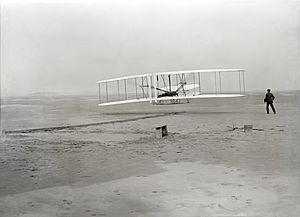
In response to European expansion, several countries began to industrialize and reform their politics like Western nations. The Meiji Restoration in Japan was successful and led to the creation of a colonial empire. However, reforms in the Ottoman Empire did little to stop its decline. China had some success with its Self-Strengthening Movement, but it was devastated by the Taiping Rebellion, the bloodiest civil war in history, which killed 20–30 million people between 1850 and 1864.
The United States became the world's largest economy by the end of the century and gained its own empire. During the Second Industrial Revolution, new technologies like electricity, the internal combustion engine, and assembly line manufacturing increased productivity again. However, industrial pollution and environmental damage, which had existed since ancient times, greatly accelerated.
The 20th Century
The 20th century began with Europe at its peak of wealth and power. Much of the world was under its direct colonial control or indirect influence. Other parts of the world were influenced by Europeanized nations like the United States and Japan. As the century went on, the global system, dominated by rival powers, faced severe challenges. It eventually changed into a more flexible structure of independent nation states.
This change was sped up by wars of unmatched scale and destruction. World War I led to the collapse of four empires: the Austro-Hungarian, German, Ottoman, and Russian Empires. It also weakened the United Kingdom and France. The Armenian, Assyrian, and Greek genocides were systematic killings and expulsions of these groups in the Ottoman Empire during World War I.
After the war, powerful new ideas became popular. The Russian Revolution of 1917 created the first communist state. The 1920s and 1930s saw militaristic fascist dictatorships take control in Italy, Germany, Spain, and other places. From 1918 to 1920, the Spanish flu pandemic killed at least 25 million people.
Ongoing national rivalries, made worse by the economic problems of the Great Depression, led to World War II. In this war, most of the world's countries, including all the major powers, fought as part of two opposing alliances: the Allies and the Axis. The main Axis powers were Germany, Japan, and Italy. The "Big Four" Allied powers were the United Kingdom, the United States, the Soviet Union, and the Republic of China.
The militaristic dictatorships of Europe and Japan pursued a path of imperialist expansion that ultimately failed. During this time, Germany, under Adolf Hitler, organized the genocide of six million Jews in the Holocaust. Japan also killed millions of Chinese people.
The defeat of the Axis powers by the Allies in World War II opened the way for communism to spread into Eastern Europe, China, North Korea, North Vietnam, and Cuba.
When World War II ended in 1945, the United Nations was founded to prevent future wars, just as the League of Nations had been formed after World War I.
World War II left two countries, the United States and the Soviet Union, with the most power in international affairs. Each was suspicious of the other and feared the global spread of the other's political and economic system (capitalism vs. communism). This led to the Cold War, a 45-year standoff and arms race between the United States and its allies on one side, and the Soviet Union and its allies on the other.

With the development of nuclear weapons during World War II, all of humanity faced the risk of nuclear war between the two superpowers. Since nuclear war was seen as too dangerous, the superpowers instead fought proxy wars in non-nuclear-armed countries. Between 1969 and 1972, as part of the Cold War Space Race, twelve American astronauts landed on the Moon and returned safely to Earth.
In China, Mao Zedong implemented industrialization and collectivization reforms as part of the Great Leap Forward (1958–1962). This led to the starvation deaths of 30–40 million people. After Mao's death, China entered a period of economic growth.
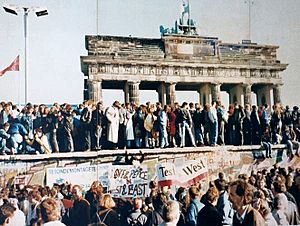
The Cold War ended peacefully in 1991 when the Soviet Union collapsed. This was partly due to its inability to compete economically with the United States and Western Europe. The United States also began to show signs of reduced global influence, and its economic inequality increased.
In the early decades after the war, the colonies in Asia and Africa of the Belgian, British, Dutch, French, and other European empires gained their independence. Most Western and Central European countries gradually formed a political and economic community, the European Union.
Cold War efforts to prepare for a third world war sped up advances in technologies like jet aircraft, rocketry, and computers. In the decades after World War II, these advances led to jet travel, artificial satellites (with uses like GPS), and the Internet. These inventions have changed how people, ideas, and information move around the world.
Not all scientific and technological advances in the second half of the 20th century needed military reasons. This period also saw groundbreaking developments like the discovery of the structure of DNA, the worldwide eradication of smallpox, the Green Revolution in agriculture, the introduction of the portable cellular phone, the discovery of plate tectonics, and exploration of space.
The 21st Century

The 21st century has seen a huge expansion of communications. Smartphones became common in the late 2000s, and the Internet has caused major changes in business, politics, and people's personal lives.
This period has been marked by increasing economic globalization and integration. This has led to increased risks for interconnected economies, as seen in the Great Recession of the late 2000s and early 2010s.
In 2020, the COVID-19 pandemic greatly disrupted global trade and caused recessions in the world economy. As of 2023, more than six million people have died from COVID-19.
Humanity's negative effects on Earth have increased due to growing human populations and industrialization. The widespread use of harmful technologies like plastics (causing plastic pollution), synthetic fertilizers, chemical pesticides, and soil tilling (leading to loss of soil nutrients) has contributed to environmental degradation. Humanity's ever-increasing demands on Earth's resources, and the failure to widely use renewable energy (like solar panels and wind turbines), are contributing to mass extinctions of plant and animal species and climate change. These issues threaten the long-term survival of humankind.
See also
 In Spanish: Historia universal para niños
In Spanish: Historia universal para niños


